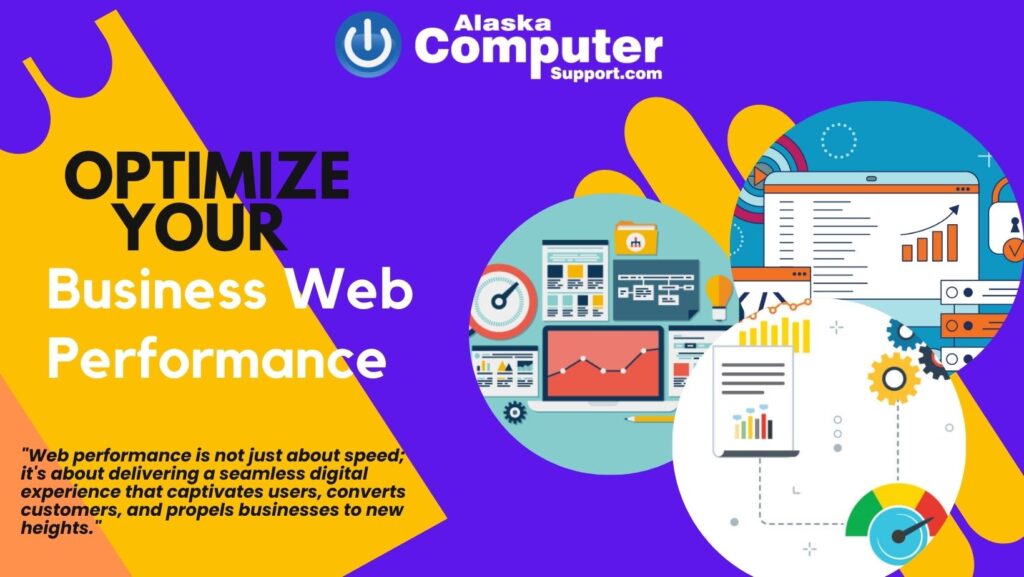How to Optimize Your Business Web Performance

In today’s digital era, web performance plays a crucial role in the success of businesses. A slow-loading, unresponsive website can drive away potential customers and harm your online reputation. On the other hand, a fast and efficient website can attract and retain users, leading to increased conversions and business growth.
This blog post will guide you on how to optimize your business’ web performance, ensuring that your website delivers an exceptional user experience. We will explore key areas to focus on for optimization and provide actionable insights to enhance your website’s speed and mobile responsiveness.
Analyzing Your Current Web Performance
To begin the optimization process, it’s essential to assess your current web performance. Two critical aspects to analyze are website speed and mobile responsiveness.
Assessing website speed
Website loading time is a critical factor that can significantly impact user satisfaction and engagement. Slow-loading websites lead to frustration and high bounce rates. In this section, we will delve into the significance of website loading time and explain why it is essential to prioritize speed optimization. Additionally, we will explore various tools and techniques you can utilize to measure your website’s speed accurately.
Evaluating mobile responsiveness
With the increasing use of mobile devices for browsing the internet, having a mobile-friendly website is no longer an option—it’s a necessity. We will discuss the importance of mobile-friendly design and how it directly impacts user experience and conversion rates. You will learn about effective ways to test and improve your website’s mobile responsiveness, ensuring that it adapts seamlessly to different screen sizes and devices.
Optimizing Website Speed
A fast-loading website not only enhances user experience but also positively affects your search engine rankings. In this section, we will explore various strategies to optimize your website’s speed.
Minimizing file sizes
Large media files, such as images and videos, can significantly contribute to slow website performance. We will provide you with practical techniques to compress images and other media files without compromising quality. Additionally, we will discuss the importance of reducing unnecessary code and scripts, streamlining your website’s resources for faster loading times.
Caching and content delivery networks (CDNs)
Caching is a powerful technique that can dramatically improve your website’s performance. We will explain how caching works and the benefits it offers in terms of reducing server load and delivering content more efficiently. Furthermore, we will explore how content delivery networks (CDNs) can enhance website performance by distributing your content across multiple servers worldwide.
Optimizing server response time
The performance of your web hosting provider directly affects your website’s response time. We will provide you with valuable tips for choosing a reliable web hosting provider that offers excellent server performance. Additionally, we will discuss server-side optimizations, such as caching, gzip compression, and database optimization, to further improve your website’s response times.
Enhancing Mobile Responsiveness
With the majority of users accessing websites through mobile devices, it is crucial to provide an optimal mobile experience. This section will focus on enhancing your website’s mobile responsiveness.
Responsive design principles
We will introduce you to responsive web design, a technique that allows your website to adapt and provide an optimal viewing experience across various devices and screen sizes. You will learn about the core principles of responsive design and how to implement them effectively.
Mobile-specific optimizations
Optimizing images and multimedia for mobile devices is essential to ensure fast-loading and visually appealing mobile experiences. We will explore techniques such as lazy loading, image optimization, and choosing the right file formats for mobile. Additionally, we will discuss the importance of prioritizing content and removing non-essential elements to create a streamlined mobile experience.
Monitoring and Testing
Optimizing your business’ web performance is an ongoing process. Regular monitoring and testing are essential to identify and address any performance issues that may arise.
Ongoing performance monitoring
We will introduce you to tools and services that enable you to track and monitor your website’s performance metrics. By regularly monitoring key indicators such as page load time, server response time, and user engagement, you can proactively identify any areas for improvement and take appropriate actions to maintain optimal performance.
User testing and feedback
Gathering user feedback is invaluable for understanding how your website performs from a user’s perspective. We will discuss the importance of user testing and how to incorporate it into your optimization process. By involving real users and analyzing their feedback, you can gain insights into potential performance issues and make informed decisions to enhance your website’s user experience.
In conclusion, optimizing your business’ web performance is vital for providing an exceptional user experience and driving online success. By focusing on website speed, mobile responsiveness, and implementing monitoring and testing practices, you can ensure that your website performs optimally and delivers outstanding results for your business. Stay tuned for the upcoming sections where we will delve deeper into each aspect and provide you with actionable strategies and techniques to optimize your website’s performance.